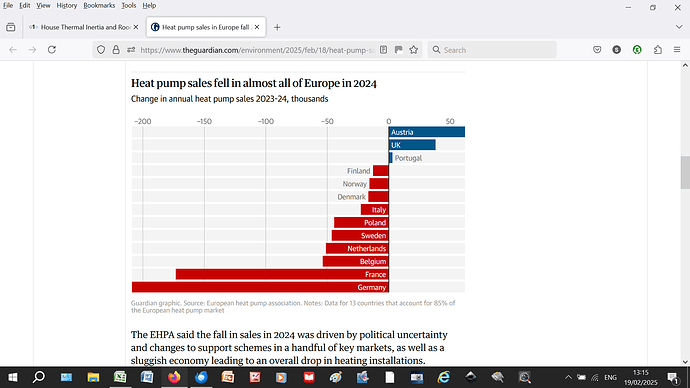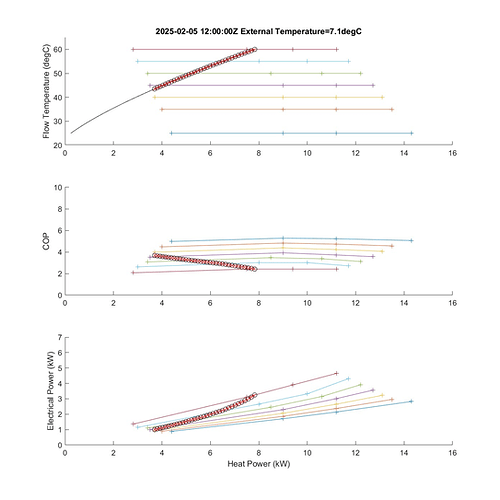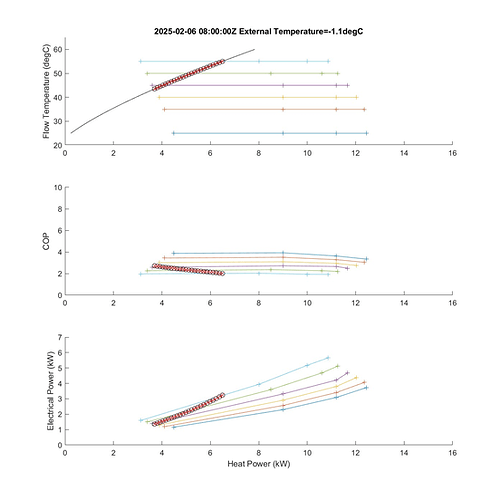If I has such a property I would want a combination of log burner, bottle gas heater and/or diesel heater for when I had no power. These could be used to help with the recovery. If possible property will be empty I would want antifreeze in system rather than antifreeze valves so heatpump would restart without needing refilling.
I’ll make another vote for turning off in the 4-7 peak. I personally find it works for me due to the thermal inertia of the concrete floor downstairs (perfectly warm enough until 10pm) and a personal preference for a cool bedroom to fall asleep in. Equally, I want that temperature to have recovered by 7am, which is the challenge.
I like Agile because it at least notionally tries to reflect system costs. Let’s say we’re backing up an 9kW heat pump that’s achieving a COP of 3 at design temperature (call it a cold dunkleflaute), so it need 3kWe. 3kW of back up generation capacity will cost about £5k. Another £5k will go in transmission /distribution upgrades. The numbers are approximate, but you get the point. Socialise everyone doing that and you’ve got the cost of a new heat pump installation (plus interest, maintenance and margin) added to everyone’s bills. By contrast, run your heat pump outside the peak and you’re getting a more steady state / base load system where the electricity system is operating at a higher average load factor and unit costs fall.
Not everyone can run like that, but most can stomach dropping their flow temperature by a few degrees for a few hours - still heating, but underheating. To Sarah’s point, recovering 100% of 3 hours missed output over 20h is running 5% harder the rest of the day, but if you still run but at a lower output, you’re still helping peak shave and have a much easier time on the recovery. Flow temperature control is about as good as we can do to achieve this until some brave manufacturer gives us frequency limit controls on compressors.
Thanks for this Sarah. It is useful helps to put some real numbers into the yawning gulf of misinformation that currently bedevils the heat pump universe. Not so much for those successfully deploying them but among the general public. The biggest hurdle I see from newspaper articles, my own experience, and my own conversations with both heat pump owners and gas boiler afficionados is that very few do not seem to fully realise the most fundamental thing that ought to be blindingly obvious. It should not need explaining but it does “A Heat Pump is NOT a gas boiler”. To make a bad situation worse a lot of what a heat pump does best is counter intuitive. Throw in a house with a large thermal mass, mine takes over 24 hours to manage even a moderate temperature change, But works perfectly steady state, then its a perfect recipe for many the the Telegraphs disaster stories.
You can install a perfect system but if the user treats it like a gas boiler the enterprise is doomed to be mediocre at best.
Sorry, I am sure that is not what you meant ![]()
Yes, there’s a ‘not’ too many. It should be
“very few seem to fully realise…”
Thanks for the correction Robert, senility is setting in here.
Yup, here’s another one in today’s Guardian:
On the bright side, maybe the UK’s bucking the trend may be partly down to forums like this? (or should that be fora, or even forae, @Robert.Wall?)
forums like this? (or should that be fora, or even forae, @Robert.Wall?)
Don’t ask me. I did French & German for ‘O’ levels, then I forget the choice but Russian was the least bad. So Latin is definitely not one of my strengths.
Germany last, it’s a shame. There’s so much misinformation being spread here about heat pumps it’s really crazy. A year before we put ours I myself was convinced it would not make sense to replace a gas boiler with a heat pump when you have old radiators. Now here I am with an extremely efficirnt heat pump at 35°C flow @ -10°C outside.
2023/2024 was an extreme drop in sales because of a legal change. People just didn’t know what to do/buy, how much money they’d be getting from the government, how long that would take etc. A complete disaster. On top of that heat pumps are much more expensive (x2-x3) conpared to the UK or France. Our government subsidies are a percentage of install costs up to 35k€, so essentially all installers will quote around that value at the minimum. I’m lucky my install is from Aira who were just getting into the market and were offering an extremely competitive price.
Just looked it up. Forum is second declension neuter, so “fora” is correct. Golly how it all comes flooding back… ![]()
This is very similar to my experience. A mere 1°C overnight setback is usually but not always enough to keep the heat pump off all night.
Its incredibly counter intuitive but having the setback did not consume less energy or save any money.
The only downsize for us running without a setback is the bedroom can be too warm to sleep, so we have used the bedroom TRV to limit the temperature in the bedroom. The main issue being the radiator is very close to the side of the bed (35cm), so you get a lot of radiated heat to that side of the bed, not at all helped by the way our Daikin dumps huge amounts of heat into the house at the start of a cycle.
My ever growing data is pointing that way too.
Set backs where the Heat Pump is off (usually controlled by room thermostat) do not save during normal winter weather.
A cold start at the cheap 4am tariff can easily gobble up any difference by letting it run low and slow until then.
That might not be true as the outside temps rise - I’ve no data on that yet.
Leaving Water Temperature reductions might not come with the same penalties.
Going to LWT scheduling only (no thermostatic control) is my next project ![]()
I have written an algorithm to heat our house at minimum cost. My reasoning is that people will only switch to heat pumps in large numbers if the running costs are substantially lower than mains gas, to offset the higher upfront cost. I think it works much the same as a Homely Smart Thermostat, but I have a Misubishi Ecodan, which is not compatible.
I used the wonderful OpenEnergy heat pump monitoring system to estimate the heat loss and thermal inertia coefficients, along the same lines as SarahH describes.
It was also used to estimate how much energy our radiators can emit at a particular flow temperature when the heating system is running in steady state – say after 2 hours at the same flow temperature. (I had always thought our radiators were too small for the heat pump – but the magnitude of the shortfall was a bit of a shock). I used the approach set out here (https://www.purmo.com/docs/Purmo-technical-catalogue-radiators-full_PR_01_2014_EN_PL.pdf page 9) to model the steady state heat output by the radiators at other flow temperatures (I assumed a constant 5 degC difference between flow and return temperatures).
I have modelled the performance of the Ecodan in terms of COP & heat output, for different flow temperatures and power settings, as external temperature varies, by interpolating the tables that Mitsubishi publish. (Ecodan_ATW_Databook_R32_Vol5.3_.pdf page 61 of 442 for our 11.2 kW model).
At the time, we were on Agile, and we have solar, but no battery storage. Octopus pays me 15p/kWh for exports, so I use this as the cost of my solar if I feed it to the heat pump instead. The algorithm runs on our PC at about 4pm every day, when the cost of Agile is released for the day ahead. It also reads in free forecasts for solar output (https://api.solcast.com.au) and outside temperature (https://api.open-meteo.com). I know roughly how much electricity will be used for other purposes around the house such as cooking, lights, computers etc at different times of the day (Open Energy again!), which eats into any solar that’s available.
The plot below shows what the Ecodan should be capable of doing when the external temperature is 7.1 degC. The circular symbols show what steady state performance is possible with my radiators (I wasn’t joking when I said our installation was bad).
When it’s colder outside, the performance drops, as expected
The algorithm weighs up all the different factors, and works out when the heat pump should run, and the optimal power output & flow temperature to minimise running cost, while keeping the room temperature between 18 and 20 degC. As Rachel Lee alludes too, on Agile it usually works out cheapest for us to heat in the early hours of the morning, and in the early afternoon. But if it’s really cold, then the heat pump needs to run for longer, and the algorithm accounts for that.
The plot below shows what the algorithm comes up with on a cold day. The cost was getting a bit eye-watering on Agile, so we switched to IOG, now that our Leaf/Zappi combo is compatible.
The algorithm seems to model reality passably well. It does not account for water heating at the moment. I would like to add a term to account for passive solar gain on those sunny but cold days. The biggest discrepancy appears to be that the lounge cools down much more slowly in the evening than the model predicts, whilst being pretty accurate when it’s unoccupied. (I always thought my wife was hot in a colloquial sense, but maybe it’s not just metaphorical …… she seems to produce more heat than an Olympic rowing eight at full power. Other explanations may be available, but I’m sticking with this one).
I am currently in the process of discovering that it’s one thing to calculate what you want the heat pump to do, and quite another to get it to actually do it! At the start of each heating period, the algorithm usually wants maximum COP, which is predicted to be at minimum compressor power and lowish flow temperature for our Ecodan. (Our heat pump installation is pretty crappy. The rads are too small, so the model says we can only run steady state with a flow temperature above about 43 degC. We don’t get much heat out of the rads at those ‘low’ temperatures). Left to its own devices, the Ecodan tends to ramp up to high power, overshoot the desired flow temperature by a country mile, and then it takes ages to bring the power down. If it comes down too quickly, then it shuts down and cycles. If I run in flow temperature mode, and constantly tweak the target flow temperature manually, I can get it to “soft start” at low power, without cycling, and it’s very efficient (relative to the low standards of our crappy installation in room temperature mode). But if nature calls, I return to find that it has cycled in my absence. I am trying to code up something in Home Assistant to automate the soft start, but it’s not reliable yet. The heat pump works really well when it’s heating the hot water in eco mode. I’m trying to do something similar in central heating mode, but at low compressor power. It feels like I want an extra control mode : a ‘compressor speed mode’ in addition to the normal Ecodan flow temperature mode, weather compensation mode and target room temperature mode. I just want to say, for example, run the compressor at 50% compressor speed (and let the flow temperature do what it wants). I would have thought that if you have small radiators it would eventually stabilise at a high flow temperature, and if you are lucky enough to have large rads it would stabilise at a lower flow temperature. But I don’t know enough about the internals of heat pumps to know whether that’s feasible.
Maybe I have just got something wrong in my heat pump setup. It’s ages since I set up the weather compensation curves…
Good work @richb99999, though I’m not quite clear what form your algorithm takes - is it an automated bit of hardware which twiddles all the necessary knobs for you, or a spreadsheet or similar that tells you what to set up manually for the next day, or something else, and is it Ecodan-specific, or could others use it if you published it (hint…)?
From what I’ve read on this forum, most heat pump manufacturers don’t anticipate users fooling around with Outdoor Unit (OU) settings beyond some form of LWT control (e.g. weather compensation) by manipulating compressor inverter speed, and maybe a Quiet Mode which typically limits inverter speed. Other OU algorithms (e.g. compressor suction/discharge pressure optimisation, defrost, circulation pump exercising, and circulation frost prevention) tend to be programmed into EEPROMs which end users are (perhaps understandably) encouraged to leave alone. (Though I’d love to see a ROM disassembly of my Samsung controller, if only to understand why it does what it does…)
I’ve tried to do a bit of reverse engineering on my HP controller, and concluded that there just isn’t enough information to make the effort worthwhile. For example, the seal oil that circulates with the refrigerant - it affects the physical properties (e.g. condensing/evaporating temperatures), and in particular has a huge effect on compressor cooling and thus apparent efficiency, but as we aren’t told the OCR (oil circulation ratio) at various compressor speeds, it’s all guesswork. (This hardly matters anyway, if we can’t change it…)
At the moment it’s just a Matlab program that runs automatically once a day on our PC. The main output is a csv file estimating what the ideal flow temperature is for each 30 minute block, over the next day. Also some pretty graphs which help with finding the inevitable bugs.
I got a Home Assistant Green a few weeks ago, and the brilliant bit of kit (https://www.tindie.com/products/fontecservice/mitsubishi-ecodan-hp-air-to-water-proxy-pcb/) which fits to the Ecodan. At the moment it’s just sending sensor data from the Ecodan to HA, and I can control the Ecodan manually from the HA front page. Hopefully, in the not too distant future, I’ll work out how to program HA to control the Ecodan to the Matlab plan, automatically. But at the moment I’m firmly at the base of the HA learning curve, and it feels like I’m standing at the bottom of the Gladiators Travelator.
I’m open to sharing the code, but I don’t know how to use Github properly (are you allowed to put Matlab programs on Github or are they for python only?)
You can put anything you like on GitHub pretty much, especially if it’s text-based.
The conclusions for my heat pump/house energy efficiency combinations seems to be OVO heat pump+ is lowest cost as with Cosy the system cannot bridge the high/medium piece periods to pull the overall price per kWh down to HP+ levels during normal and cold winter days even though Cosy TOU tariff applies to all house electricity, not just HP.
This would change if I had a battery, if my house was more tightly sealed (currently B rated) or perhaps if the heat pump had more excess capacity. But if current thinking has changed to encourage JoeandSusie-Public to go “heat pump then retrofit” to get immediate carbon savings, then HP plus all-day low tariffs will be more financially attractive than TOU.
This doesn’t smooth demand to help grid but public policy needs to make sense at individual level to gain compliance.
To smooth demand, DHW reheat must be forced outside of peaktime and heatpumps used 24/7 rather then trying to reheat home from cold just before everyone gets home. OVO does have a small reward for people who move washing etc to overnight.
Agree. What I do not understand is that the incentive/reward to shift demand outside of peak ours is around 3p per kWh but Agile has hit 100p kWh and is typically average 40p per kWh in peak times, then why is the shift incentive not used more widely and made more attractive?
Demand shift should be viewed as a competitor to the 2-3 companies that provide “emergency” gas-fired supply and charge high rates, often by delaying their price offer until there is no alternative.
If people are fearful of costs they can’t predict it stops them charging tariff. It takes little incentives provided easy to understand to get people changing when they use dishwasher and washing machines on most days. But must not have a risk of them losing out if they don’t change enough behaviour.



